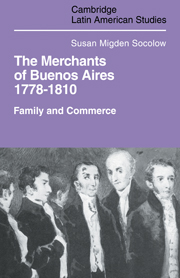Book contents
- Frontmatter
- Contents
- Dedication
- Acknowledgments
- Glossary
- Weights, measures and money
- Introduction
- 1 The merchant population
- 2 Women, marriage and kinship
- 3 Commerce and investment
- 4 Life style
- 5 Religious participation
- 6 Political and social awareness
- 7 Gaspar de Santa Coloma, merchant of Buenos Aires
- Conclusion
- Appendices
- Notes
- Bibliography
- Index
1 - The merchant population
Published online by Cambridge University Press: 04 August 2010
- Frontmatter
- Contents
- Dedication
- Acknowledgments
- Glossary
- Weights, measures and money
- Introduction
- 1 The merchant population
- 2 Women, marriage and kinship
- 3 Commerce and investment
- 4 Life style
- 5 Religious participation
- 6 Political and social awareness
- 7 Gaspar de Santa Coloma, merchant of Buenos Aires
- Conclusion
- Appendices
- Notes
- Bibliography
- Index
Summary
Although merchants were among the major local beneficiaries of the restructured political and economic system of the last decades of the eighteenth century, the merchant group of Buenos Aires was not created by the new Viceroyalty. Buenos Aires, from the seventeenth century, had a relatively clearly defined and important merchant group, active both in the legal trade authorized by the Spanish Crown, and in contraband dealings with the Portuguese, English and French.
As early as 1597, only seventeen years after the re-establishment of the port city, Portuguese merchants began to import shipments of dry goods and slaves into Buenos Aires. By 1615 several important merchants and their families were established in the city. Included in this group heavily involved in contraband, were Diego de Vega and his son-in-law, Juan de Vergara. Throughout the seventeenth century, porteño trade (usually contraband) was dominated by Portuguese merchants, although occasionally a Spaniard rose to prominence among the merchant ranks. Such a case was that of Miguel de Riglos, a native of Navarre, and one of the principal merchants of the late seventeenth and early eighteenth centuries, who had begun his commercial life through his auspicious marriage to the widow of a Portuguese merchant.
It is impossible to estimate the number of men involved in commerce during the seventeenth century, for no census with good occupational information exists for this period.
- Type
- Chapter
- Information
- Merchants of Buenos Aires 1778–1810Family and Commerce, pp. 12 - 33Publisher: Cambridge University PressPrint publication year: 1978



